Climate Disasters on the Planet from March 29 to April 04, 2024: Summary
Asia
China
Deadly convective storms struck China at the end of March.
352,000 people were affected by hurricane winds, rain, and hail in Jiangxi Province, with seven fatalities.
On the night of March 31, in the city of Nanchang,
a powerful gust of wind shattered windows from floor to ceiling
in a multi-story building.

Aftermath of hurricane winds in Nanchang City, Jiangxi Province, China
The gust was so strong that it swept three people, while they were sleeping, directly through broken windows on the 20th and 11th floors. Unfortunately, there was no chance of survival for them.
A resident living on the 20th floor of the damaged building reported that her family had to hold on to avoid being swept away by the wind and that they were so frightened that they didn't sleep all night.
The maximum wind speed in this region on March 31 was recorded at the Tangnan Hongxing meteorological station at 4 a.m., reaching 35.3 m/s.
According to meteorological standards, the maximum average wind speed near the typhoon's wind circulation center ranges from 32.7 m/s to 41.4 m/s, or the force 12 to 13 on the extended Beaufort scale, which is used in China to classify wind strength. So, the wind speed in Nanchang was comparable to that of a typhoon.
Meng Minhua, the chief meteorologist at the Nanchang Meteorological Observatory, stated that the actual wind speed at the incident site could have been even higher than what was observed at the meteorological station.
It is worth noting that wind levels of 10 to 11 are considered critical for a person to be able to stand.
According to the Flood Control and Drought Relief Headquarters in Jiangxi Province, as of April 5, 3,856 people had been displaced from their homes. 48 houses collapsed completely, and 14,496 were damaged.
The storms also damaged agriculture, affecting 25,700 hectares of crops. Direct economic losses exceeded $35 million.
On April 2, another strong storm trapped people in a collapsed house in the same city.
Elderly residents of the city say that
they have never seen such strong winds in their lives.
Saudi Arabia
For nearly a month now, storms, floods, and hail have been wreaking havoc in various regions of Saudi Arabia. But since March 29, something unprecedented has been happening: in the world's second-largest desert,
torrential rains have not ceased for a week now,
accompanied by thunderstorms and hail, and in some regions, even snow.
This has led to torrents of hail rivers in valleys and wadis across the country.
On March 31, in the Al-Bahah Province, a record 55 mm of precipitation fell in a day, compared to the March monthly average of 15.92 mm. In other words, in 24 hours, it rained 3.5 times more than in the entire month!
Many highways and roads are flooded. “Red level of danger” has been declared in several regions.
The water level in 15 dams has exceeded their capacity.
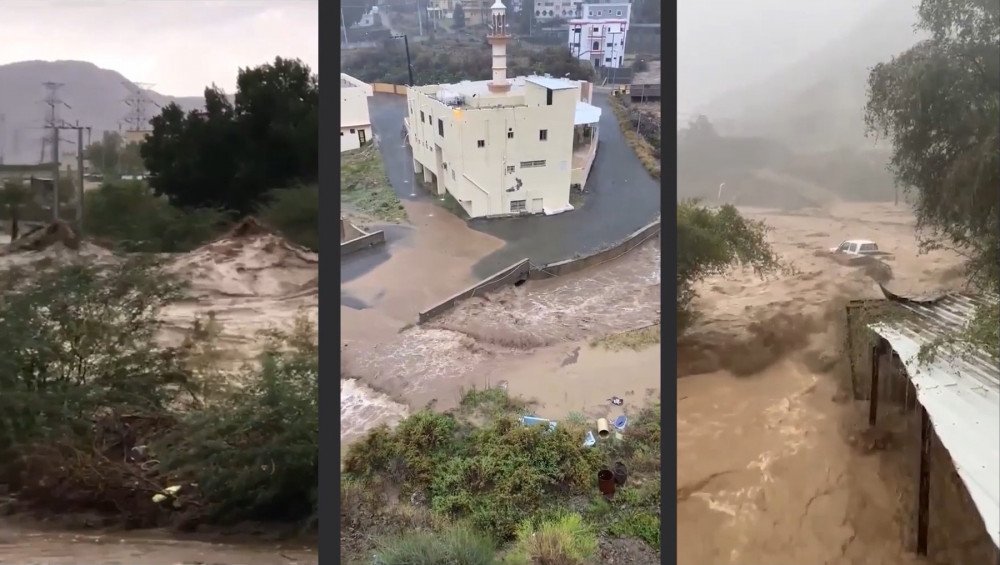
Unprecedented floods in Al-Bahah Province, Saudi Arabia
The Ministry of Environment, Water Resources, and Agriculture recommended that people stay away from valley rivers where dams are located and follow safety instructions.
In the 'Asir Province, the streets of Al-Namas town were covered in snow. This phenomenon occurred
for the first time in the region in almost 25 years.
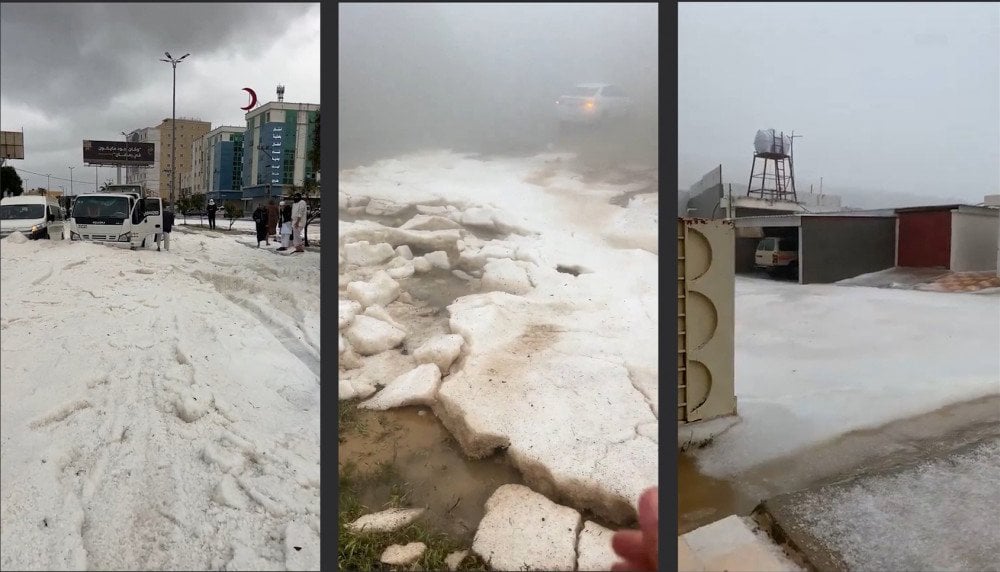
Atypical snowfall in Al-Namas, 'Asir Province, Saudi Arabia
In Abha and other cities, the air temperature dropped to below +10°C, and fog appeared.
The scale of the flooding in Saudi Arabia was commented on by Dr. Abdullah bin Ahmed Al-Jazea, former Vice President of the General Authority of Meteorology and Environmental Protection of Saudi Arabia, who said, “I have spent 35 years in meteorology
and have never seen or heard of such severe floods.”
After intense rains and floods in the northeast of the Kingdom, an unusual and alarming phenomenon was recorded: swarms of millions of beetles flooded the streets.

Mass emergence of beetles in the northeast of Saudi Arabia
India
On March 31, a severe storm caused massive destruction in four states of India: West Bengal, Assam, Mizoram, and Manipur.
The storm caused damage to the Lokpriya Gopinath Bordoloi International Airport in Guwahati. The airport building was flooded, walls and roofs were severely damaged. Fallen trees blocked roads, making it difficult for people to access the airport and for fuel delivery to the terminal. Many flights had to be canceled.
Jalpaiguri district in West Bengal suffered the most damage after being hit by a tornado and heavy rain with hail simultaneously.

Destructive storm in India
The storm of immense power easily scattered motorcycles, cars, and debris from houses along the streets. Trees were uprooted, power line poles were knocked down, about 800 houses were damaged, and agricultural land was also affected.

Tornado in Jalpaiguri district, West Bengal state, India
As a result of the raging disaster, 5 people died, more than 300 were injured, with 42 of them in critical condition.
Bangladesh
On March 31, heavy rains with hail brought chaos and destruction to some districts of Bangladesh. At least 140 people were injured.
In Sunamganj district, at least 500 houses were damaged.
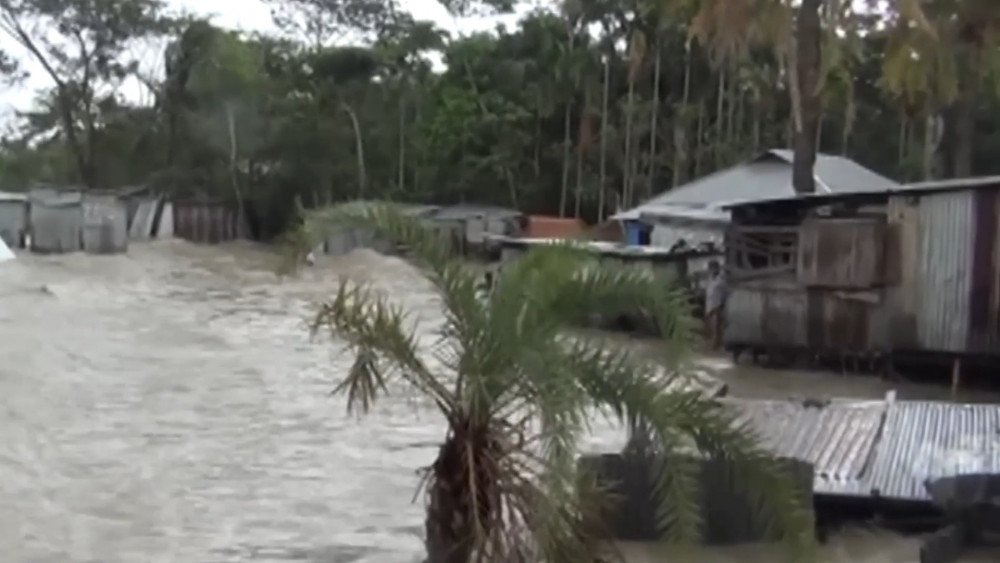
Aftermath of heavy rains in Bangladesh
Abnormally large hail fell in Sylhet district. A local resident said, “Although there have been hailstorms before,
the size of the hailstones this time was unprecedented,
causing damage to many houses.”
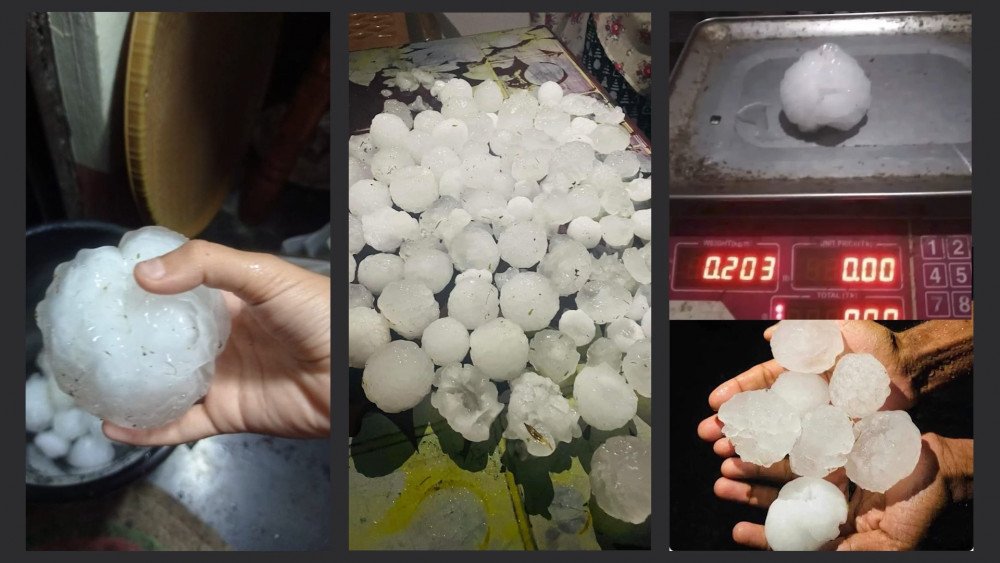
Abnormally large hail in Sylhet district, Bangladesh
Many people shared photos and videos on social media showing damaged cars, tin roofs, and windows of their homes.
However, the Bangladesh Meteorological Department's weather bulletin had not provided any information about the extensive hailstorm in Sylhet in its 72-hour forecast.
Taiwan
On April 3, near the island of Taiwan, a 7.2 magnitude earthquake occurred (according to the Taiwan Seismic Monitoring Agency). The disaster struck at 7:58 local time. The epicenter was in the sea, 25 km southeast of Hualien County, at a depth of 15.5 km.
In just the first day, there were over 260 aftershocks, including powerful quakes above 5.0 magnitude and one above 6.0.

Strongest M7.2 earthquake in 25 years on Taiwan Island
This earthquake became
the most powerful on the island in the last 25 years. It resulted in the deaths of at least 10 people, with over 1,000 injured.

Homes destroyed during the M7.2 earthquake on Taiwan Island
The earthquakes triggered numerous landslides and rockfalls. People found themselves trapped in mines, tunnels, and buildings.
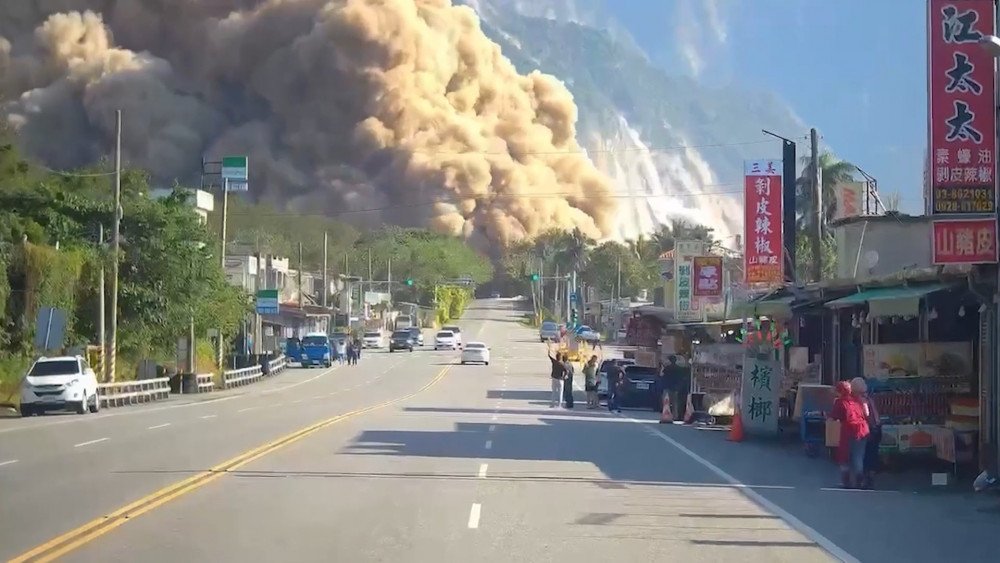
Aftermath of the earthquake on Taiwan Island
Subway and high-speed rail operations were suspended. According to the Taiwan Road Bureau, some highways were closed as a precautionary measure.
Large-scale catastrophes not only cause damage to the country where they occur but often have an impact on the global economy. For example, Taiwan is home to 92% of the world’s most advanced chip production. Even minor disruptions in the operations of these facilities can significantly disrupt the entire process of global supply chains.
Europe
At the end of March, Europe was covered with dust from the Sahara.
The Sahara Desert releases between 60 to 200 million tons of mineral dust per year. While larger particles rapidly back down to earth, smaller ones can travel thousands of kilometers, reaching the European continent.
This time, Europeans witnessed
a more intense natural phenomenon
than usual. A haze of Saharan dust engulfed Switzerland and southeastern France, coloring the sky in a yellowish hue.
Since the dust concentrated at altitudes below 3,000 meters, air quality was particularly affected – monitoring showed elevated levels of particulate matter in the atmosphere.
Meteorologist SRF Meteo, Roman Brogli, commented: “Calculations estimate that the amount of dust reached around 180,000 tons,
double the levels
recorded during recent similar events.”

Sahara Desert dust cloud over the French Alps
From the middle of the week, the Greek capital Athens was also affected by this phenomenon. The situation was exacerbated by abnormally high temperatures in Greece for this time of year. On March 27, the temperature in central Athens was recorded at around +25.3 °C, setting a monthly record, while in Crete, the temperature even reached +32 °C.
At the same time, other European countries experienced abnormal summer heat. Multiple records were shattered by a significant margin. Naturally, this weather anomaly triggered destructive storms with thunderstorms, heavy rainfall, and hail.
Ukraine
Starting from March 30, very warm air from the African continent began to flow into the territory of Ukraine. The average daily temperature exceeded the norm by 5–12 degrees,
with numerous temperature records broken.
On April 2, almost 300 settlements were left without electricity due to squally winds. In total, about 115,000 people were left without power in Ukraine.
The Kyiv region suffered the most. In the capital, strong winds broke trees and tore roofs off houses.
A powerful dust cloud, passing through Europe from March 31 to April 3, spread to most regions of Ukraine.

Hurricane-force winds scatter Sahara dust through the streets, Ukraine
Strong gusts of wind carried Sahara dust at a furious pace, making it difficult to breathe on the streets.
Poland
The hurricane-force wind that struck southern Poland on April 1 resulted in the deaths of 5 people.

Aftermath of the hurricane wind in Poland
In the Podhale region, on the peaks of the Tatra Mountains,
wind gusts reached 43 m/s. The wind knocked down trees and tore roofs off houses.
The squally wind followed the three days of unusually warm weather.
For instance, on March 30, the temperature in the southern city of Tarnów reached
a new historical record for this month,
rising to +26.4 °C.
France
After two days of torrential rains, rivers in western France overflowed their banks, leading to historic floods. Over 48 hours, nearly two months' worth of rainfall fell in three departments (Haute-Vienne, Vienne, and Indre-et-Loire).
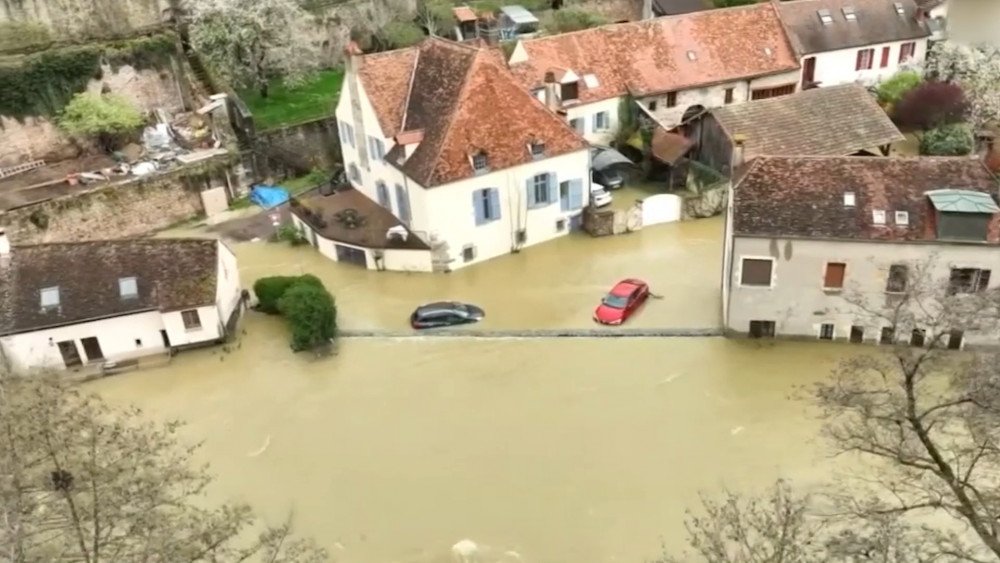
Record floods in France
The level of the Creuse River in the canton of Descartes
rose to 7.34 meters, breaking the record set 101 years ago
(in 1923).
Dozens of roads are closed, and streets in cities have turned into lakes. Hundreds of residents had to be evacuated.
Local residents said:
“I've never seen anything like this.
For us,
this is the flood of the century”, “The flood came
too suddenly”, “We're used to the river rising, but
not at this rate.”
Russia
Dangerous weather phenomena are gaining momentum in Russia.
April started with abnormal warmth in the European part of the country. Over 3 days, from March 31 to April 2, more than 170 temperature records were broken in 19 regions!
On April 2, a record high temperature was set in Moscow,
the highest in all 145 years of weather observations
in the region. The air warmed to a fantastic +23.2 °C for this date.
In St. Petersburg, a day earlier,
an absolute record was also recorded — almost summer-like +19.6 °C.
In Smolensk, it was even +25.6 °C — as in July.
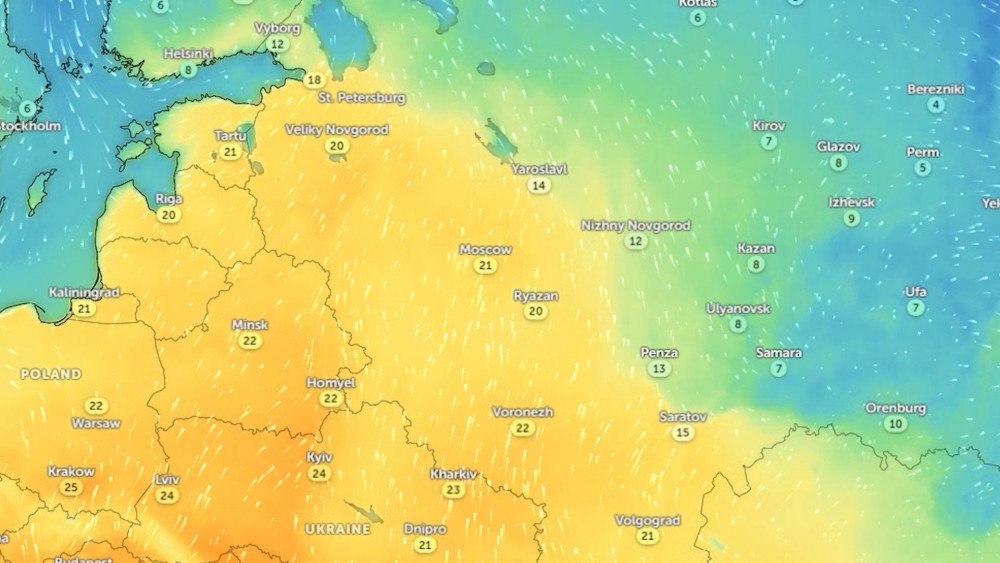
Record-breaking unseasonal heat in the European part of Russia
But on Wednesday, April 3, a cold atmospheric front from the Baltic cyclone "Patricia" dramatically changed the weather situation in several regions of the country.
In Smolensk and the Republic of Karelia,
the temperature dropped below zero within a day, in some places by 20 degrees.
After three days of record heat, Moscow was hit by storm winds up to 21 m/s and rain, and in some areas, there was hail. The wind tore off roofs, knocked down bus stops, and uprooted trees. The disaster claimed the lives of two people, and 17 were hospitalized.
In St. Petersburg,
following the absolute heat record,
thunderstorms with hail occurred. They were followed by
winter weather with snow and temperatures dropping to -4 °C.

Downpours with hail in St. Petersburg, Russia
In the Leningrad Oblast, chaos reigned as well.
Freezing rain and heavy snowfall hit the north of the region, temperatures rose to +16 °C in the south, and fog settled in the east of the region.
North of Lake Ladoga,
18 cm of snow fell.

Sudden cooling and snowfall in St. Petersburg, Russia
The sudden and anomalous warmth in March led to rapid snow and ice melt, resulting in a swift rise in river levels and flooding of adjacent areas.
As of April 5,
36 regions
of the country are affected by extremely severe floods.
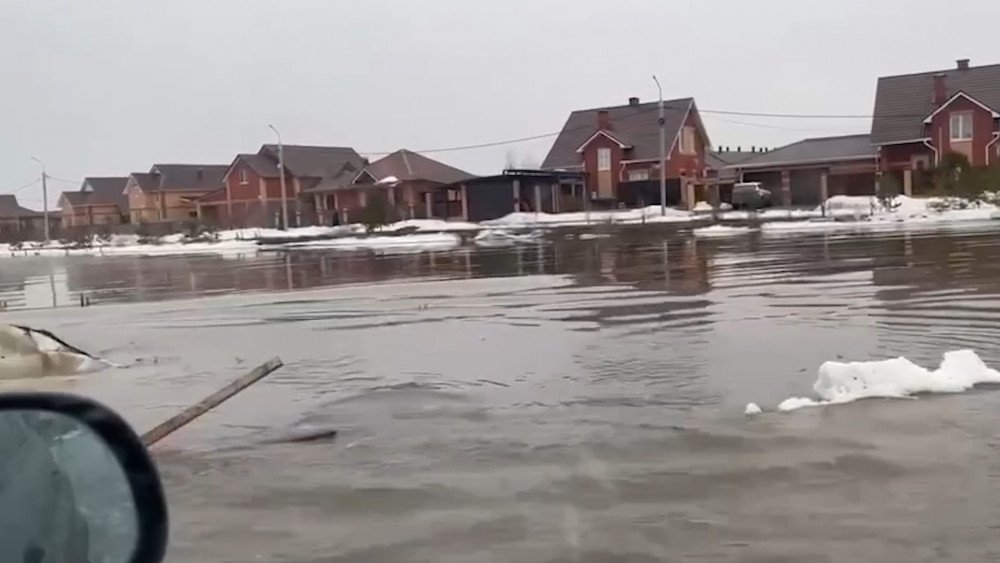
Abnormal floods in Orenburg Oblast, Russia
Abnormal floods occurred in the Orenburg region of Russia on April 5 when the Ural River breached the dam in the city of Orsk, leading to severe flooding. More than 2,500 houses were inundated. An emergency evacuation was declared. Over 4,200 people were evacuated from flood zones.
The level of the Ural River near the breached dam in Orsk is 9.6 meters.
However, the hydraulic structure is designed for only 5.5 meters.
The peak of flooding in the region has not yet passed, and water continues to arrive.
Massive floods also occurred in Siberia: in the Novosibirsk, Kemerovo, Tomsk regions, and in the Altai Krai.
Here, climatic spring came almost
2 weeks ahead of schedule.
In the Altai Krai, a state of emergency was declared at the end of March. Due to high water levels, some road sections were closed. Hundreds of houses were flooded.
In the Novosibirsk region, water rose so high in some areas that people were wading waist-deep.
In the Chelyabinsk region, a stream of water washed away a bridge. It was the only crossing for residents of the nearest village. Rescuers delivered food and medicines by water.
According to the Ministry of Emergency Situations, floods in the Samara region were
the strongest in 35 years,
and in the Vologda region,
such a flood had not been seen in 58 years.
In the city of Khimki, Moscow region, the water was so high that residents had to move around in inflatable boats. According to eyewitnesses, there has never been such flooding in this area before.
North America
USA
In early April, a series of storms swept across a vast territory from the central states to the northeast of the USA.
On April 1st,
the largest hail, measuring up to 11 cm,
was recorded in the state of Texas. Several tornadoes also occurred across the country on the same day.

Hailstone of a huge size in Texas, USA
On April 2nd and 3rd, disasters continued to wreak havoc across the country.
On Tuesday and Wednesday morning, 16 tornadoes were reported in Illinois, Kentucky, Ohio, Alabama, Tennessee, and Georgia, along with dozens of reports of destructive winds.
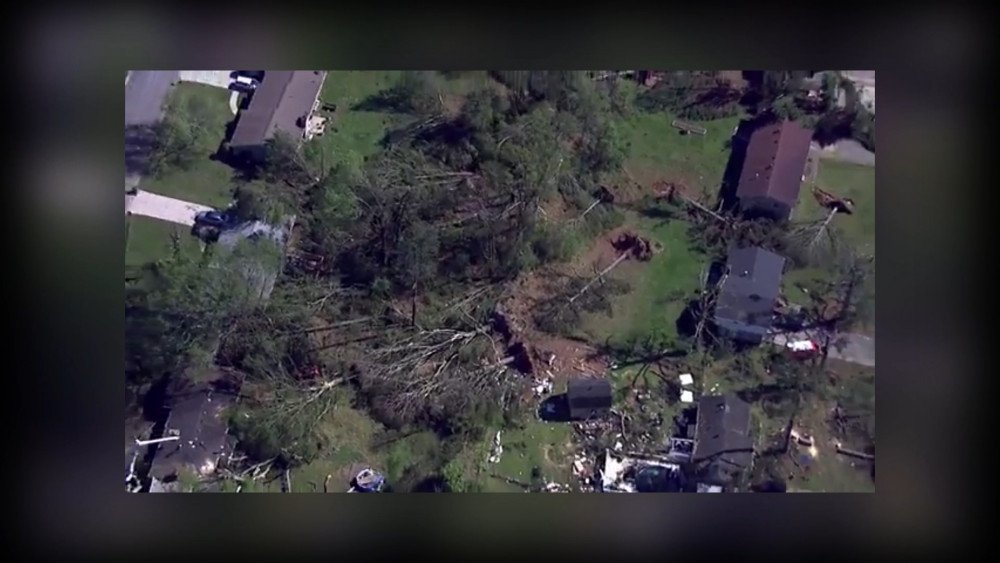
Destructive aftermath of storms in the USA
On Tuesday, a state of emergency was declared in several counties in West Virginia. Severe thunderstorms led to flooding across the state.
In southern Indiana, strong winds overturned several vehicles on Highway 265, completely blocking several lanes of traffic.
In Kentucky, in Boyd County,
wind gusts of up to 164 km/h were reported,
resulting in serious infrastructure damage.
The storm system also left a trail of destruction in Tennessee. An EF-2 tornado hit the city of Conyers, Georgia, near Atlanta.
The storms claimed the lives of four people, and dozens were injured.
Turbulence
On March 29, a United Airlines flight from Tel Aviv encountered severe turbulence.
The flight crew reported an emergency situation, leading to the flight being diverted north to Stewart International Airport in New York state. The aircraft had to make an emergency landing there. Twenty-two passengers were injured, with seven requiring hospitalization.

Emergency landing of a United Airlines aircraft at Stewart International Airport in New York state, USA
On April 3, during a Southwest Airlines flight from New Orleans to Orlando, two people were injured due to severe turbulence. The captain declared an emergency, and the plane made a forced landing in Tampa, Florida. The injured were taken to a medical facility
And 3 weeks ago, during a flight from Sydney, Australia, to Auckland, New Zealand, severe turbulence occurred, injuring 50 people. Twelve of them were hospitalized. One person was in critical condition, while the others had moderate to minor injuries.
It's alarming that more and more often airplanes suddenly start losing altitude. They literally plunge into air pockets, resulting in serious injuries and even human casualties. Currently, all such incidents are attributed either to aircraft technical malfunctions or to clear-air turbulence.
However, the main cause remains unaddressed, while the number of airplane accidents is growing as fast as the number of climate disasters on the planet as a whole. It's all part of the same chain. Flying has already become dangerous, and with this trend, the cancellation of all flights is what awaits us in the near future.
Detailed information on the causes of such anomalies is presented at the forum
“Global Crisis. The Responsibility.”
You can find the video version of this article
here:
Leave a comment